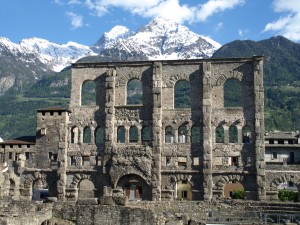Martigny, Switzerland to Aosta, Italy
It is overcast as we leave Martigny in the early morning. We drive alongside the river, its grey green water splashing over smooth well-worn rocks. Soon we are driving up into the mountains, through the occasional tunnel and avalanche shelter. The very peaks of the mountains are shrouded in cloud but there are a few patches of blue sky. We drive through tiny Swiss villages as we climb. The beautiful green conifers that cover the mountain now have a slight sprinkle of snow on them. Then around a corner is the village of Bourg-Saint-Pierre, the last Swiss village before the St Bernard Tunnel and the border with Italy. It has obviously snowed last night! All the cars are covered with about 5cm of snow, each house has a white roof and outdoor chairs have a layer of snow! But what puzzles me is not one chimney has smoke coming out! Are the people not cold inside? Or is there some other form of heating? We are soon in the tunnel, coming out right at the top for the bus driver to check for more passengers. It is still very cloudy. Back in the tunnel and 15 minutes later we emerge to a bright blue sky and brilliant sunshine! What a difference! We begin our descent down into the Aosta Valley and soon we are in Aosta itself. Quite surprisingly, we discover Aosta is bilingual with Italian and French the two languages taught. English is not spoken so widely here so I resort to my limited French. Founded in 25 BC by the Romans, Aosta, the capital of the Valle d'Aosta, has some amazing Roman ruins. One of the original city gates is still standing and, to quote from the brochure, "it has two parallel rows of arches which are 12 metres apart: the two side ones were for pedestrians while the larger central one for carriages. On both sides, the remains of the Roman dating back to 25 BC, whose perimeter is almost perfectly preserved, can still be seen." In fact, the Office of Tourism is built neatly between the two rows of arches on one side of the street. Also still standing is one wall of the Roman theatre built in the 1st century A.D and extended 200 years later.  Historians believe it could hold between 3000 and 4000 people! To the locals, the Roman ruins are just part of their town. Many houses are built into the walls. We walk down the main street looking into the shop windows and browsing in some. A group of primary school children walk past us and one of them is singing "We all live in a yellow submarine...." at the top of his voice! We have walked past several gelaterias and they look so good so maybe it's time to turn around........
Historians believe it could hold between 3000 and 4000 people! To the locals, the Roman ruins are just part of their town. Many houses are built into the walls. We walk down the main street looking into the shop windows and browsing in some. A group of primary school children walk past us and one of them is singing "We all live in a yellow submarine...." at the top of his voice! We have walked past several gelaterias and they look so good so maybe it's time to turn around........